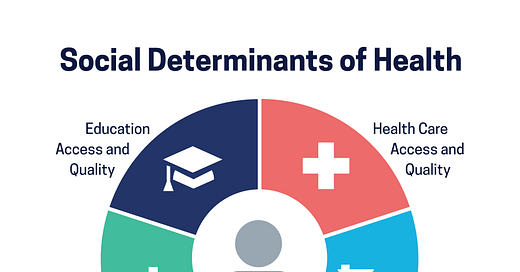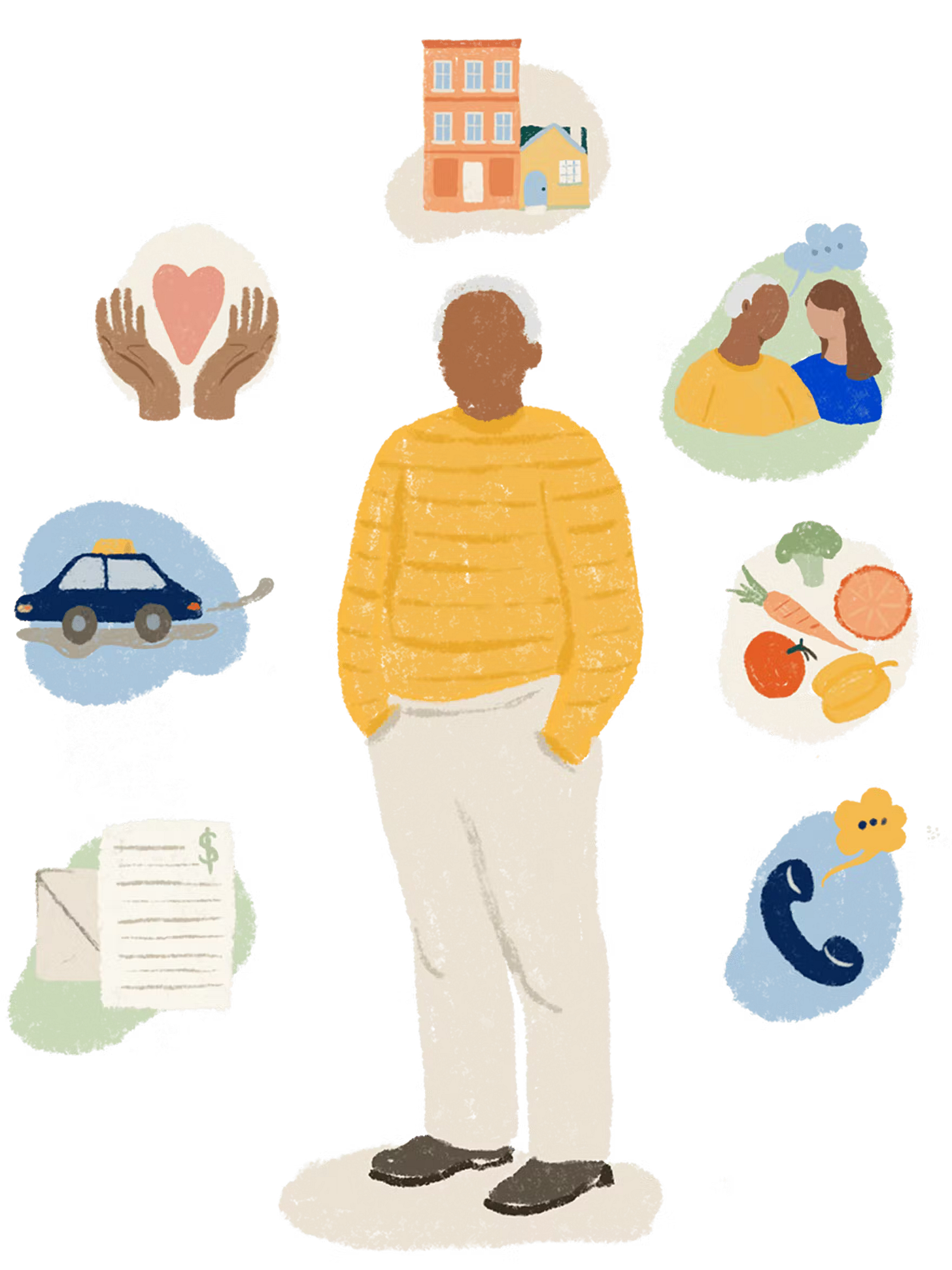What are Social Determinants of Health?
Welcome to this week’s edition of Vitamin Z, a newsletter about health and wellness with 3,000+ subscribers. If you are new, you can join here.
How does our environment shape our health? From the neighborhood we grow up in, to our friends, our job, our socioeconomic status—all of these influence our health in profound ways.
I spoke to my friend Eric at the start of the Covid pandemic. He was working for the City of Los Angeles to secure food and shelter for people experiencing homelessness. Eric told me LA has the highest rate of food insecurity among major US cities. Lack of access to healthy food was correlated with worse Covid outcomes for the city’s unhoused populations.
There’s a growing recognition in healthcare that health challenges begin at home.
Social determinants of health (SDOH) are non-medical factors that influence health outcomes and health inequities and include the conditions in which people live, learn, work and play. They can be grouped into 5 categories:
Economic stability
Education access and quality
Health care access and quality
Neighborhood and built environment
Social and community context
A recent large national study of primary care clinics and emergency departments found that 65% of patients had one or more social needs. The most common needs were related to housing (52%) and food (41%).
The link between an unhealthy diet and poor control of chronic illnesses such as diabetes, hypertension, and heart disease is well established. Addressing food insecurity may lead to better control of these conditions and lower health care costs.
Why are more health systems looking at SDOH?
Today, we’re seeing an increased focus on patients’ home and work environments and their social needs. This trend is driven by a few things:
Value-based care: There’s increasing use of value-based contracts between health care payers and providers. These contracts place greater importance on non-clinical factors that impact health outcomes. A patient’s SDOH score affects how these health systems are reimbursed.
Health equity: The use of SDOH is seen as an important way to address issues of health equity. A study found that patients with food insecurity were more likely to be Black, have Medicaid, and have a lower income.
Medicaid expansion: The number of people in the US enrolled in Medicaid / CHIP has grown by 16 million since February 2020. Most states are shifting their Medicaid members to Managed Care Organizations (MCOs), third-party health insurance carriers that have contract requirements related to social determinants of health.
How to screen people for social needs
More health systems are screening patients for social needs and referring them to community service organizations for assistance. Screening for SDOH may occur in-person, by telephone, or online through a patient portal questionnaire.
The questionnaire used by the MetroHealth System in Cleveland, Ohio, asks about 9 topics: food insecurity, financial strain, transportation limitations, inability to pay for housing or utilities, intimate partner violence, social isolation, infrequent physical activity, daily stress, and lack of internet access.
The questions include:
Physical Activity: On average, how many days per week do you engage in moderate to strenuous exercise (like walking fast, jogging, dancing, swimming, or biking)?
Food Security: In the last 12 months, have you worried your food would run out before you had money to buy more?
Social Connections: In a typical week, how often do you get together with friends or relatives in person, or talk with them on the phone?
Once a physician identifies a particular social determinant with a patient, they can make a referral to a care manager for assistance. Or they can use 211.org: Anyone in the US can dial 2-1-1 to get connected to care managers who can address things like child care, food insecurity, housing insecurity, support to find work, or mental health resources.
Staff members review SDOH responses and ask patients with social needs for permission to refer them to community service organizations. For patients struggling with food insecurity, hospital staff may help them to identify local food resources, access emergency food pantries and distributions, and apply for the Supplemental Nutrition Assistance Program (SNAP).
Laura Zimmermann, MD, chief of general internal medicine at Rush University Medical Center in Chicago, spoke about SDOH screening in an interview with the American Medical Association (AMA).
Dr. Zimmermann said:
“We’re looking at food insecurity in our patients with diabetes who are part of our Medicare Shared Savings plan. We've opened a food pantry onsite that serves our clinic patients. We know that food insecurity is associated with poor diabetes control.
If we can show that when we screen these individuals for food insecurity, link them to resources, their diabetes control is actually better, that's a clear return on investment. Any individual physician can do this.”
Overcoming barriers
Healthcare leaders say there are challenges to capturing the value of SDOH screening and interventions:
Health system buy-in
There’s a cost incurred from implementing systems for SDOH screening and care management referrals. Healthcare systems need to be convinced these interventions are cost-effective and easy to use.
Documentation
Once you capture a patient’s SDOH data, how do you use it effectively? Clinicians and staff need a good place to document a patient’s social needs and determinants in electronic medical records (EMRs). New features in EMRs like Epic are making it easier for healthcare providers to document a patient’s SDOH and track them over time.
Evidence
Healthcare leaders need to show that addressing SDOH leads to improved outcomes and improved ROI for a health system. It’s important to know how well the process works overall and for specific patient subgroups.
A 2017 study identified 39 individuals with housing insecurity who had been hospitalized multiple times, with multiple ER visits. A physician group implemented interventions that addressed social needs. They were able to show that these interventions generated savings of $1.3 million to the health system.
Startups focused on social determinants
A new wave of technology startups is tackling social determinants of health challenges.
Soda Health raised $25 million earlier this month for its supplemental benefits system that addresses social determinants of health, including access to healthy foods and transportation.
Socially Determined raised $26 million in June for its platform that allows healthcare providers, and insurers to visualize the potential social factors behind patients' and populations' health.
Cityblock Health offers a combination of primary care, behavioral health, and social services with a focus on Medicaid populations. Their social workers have regular touchpoints with the patient to coordinate care, screening, and non-clinical needs.
Improving health equity for all
My late father was a cardiologist. Many of the sickest patients he treated were from low-income communities. He told me about the challenges he faced treating patients with heart failure. He’d put them on medications and tell them to make lifestyle changes—diet, exercise, smoking cessation—to prevent their condition from worsening. Unfortunately, it’s hard to get people to change their lifestyle. Many of his patients ended up back in the hospital a few weeks later.
Our country has an epidemic of chronic illness. Our life expectancy is lower than that of many other developed countries. Expanded use of SDOH screening and care referrals could be part of the solution.
Health systems should have enough trained staff to administer SDOH screening questionnaires and make referrals. Researchers can determine the long-term impact of these programs on patient health, cost, and quality of life outcomes.
These efforts have the potential to alleviate the access gap to high-quality care in underserved and marginalized communities.
The hope is that we can improve the wellbeing of everyone on the planet—no matter who they are or where they come from.
Thank you for reading this week’s edition of Vitamin Z.
Until next time,
By Daniel Zahler
Hi there and thanks for reading. If you stumble on my newsletter, you will notice that I write about health and wellness, and ways to optimize cognitive, physical and emotional health. I work with the world’s leading healthcare and life sciences companies to develop innovative new solutions to improve health globally. I was trained as a research scientist at Harvard, and I serve as a GLG council member where I advise global business leaders on healthcare innovation.
Enjoyed your reading experience?
Follow me on Twitter.
Hit reply with your feedback and ideas :)
Share this post with others.
If you liked this newsletter, why not share it with a friend?







